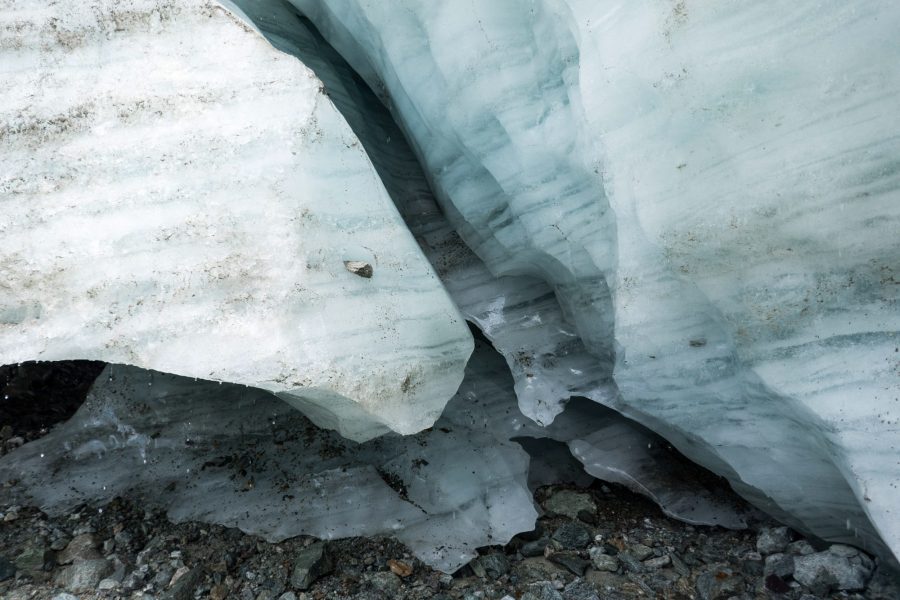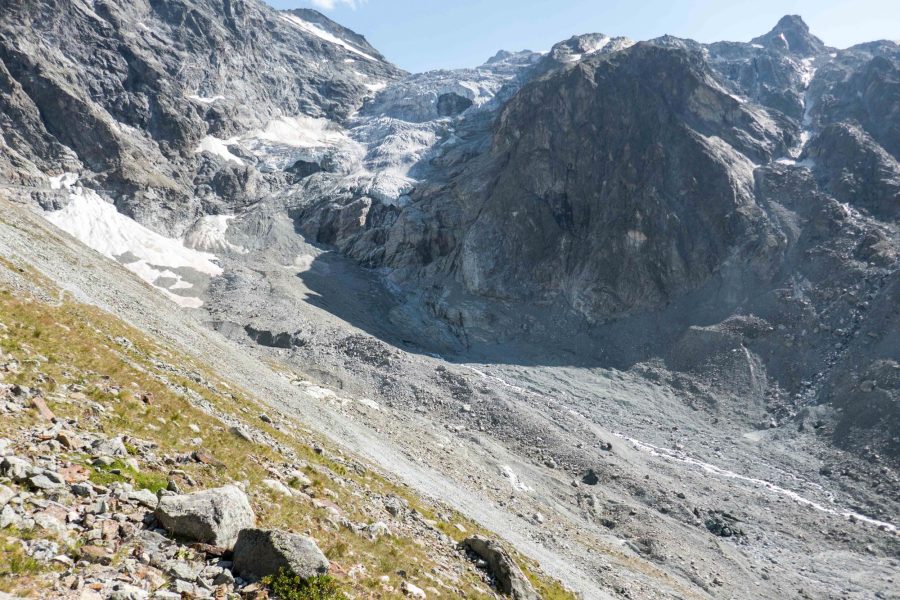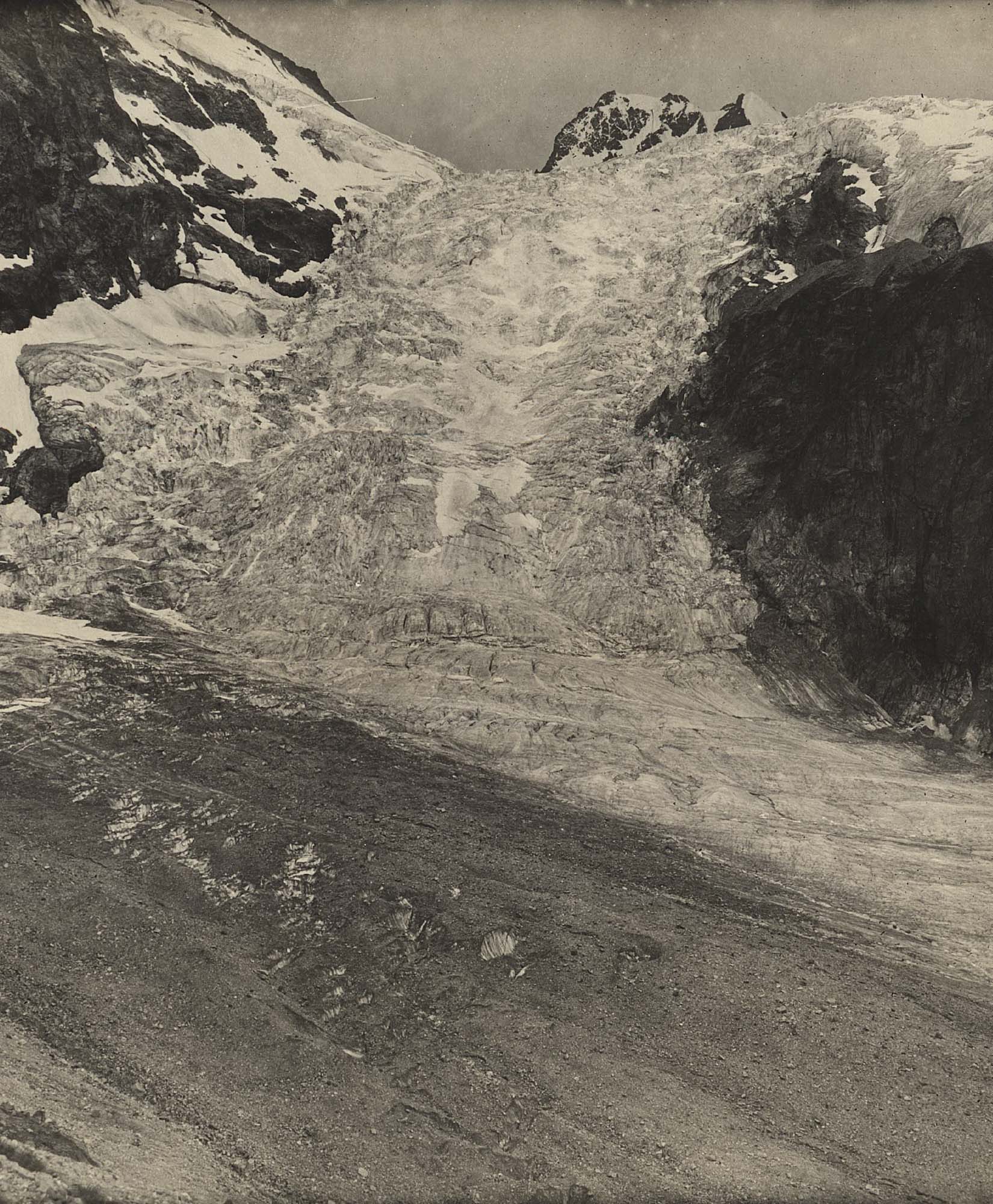Hidden deep inside the mountains of Valais lie two glaciers that used to merge into Glacier d’Arolla (Arolla Glacier). Nowadays, they are separated and go by the names of Haut (Upper) and Bas (Lower) Glacier d’Arolla.
Arolla is one of the highest villages in the Alps, situated at 2000 m above sea level. For centuries it overlooked the eponymous glacier. Never were they closer to each other than in 1817. At the time, the glacier killed trees by burying or bulldozering them. Over two centuries later, their death date could be determined by dendrochronology, a technique based on the sequence of tree ring widths (Le Roy et al., 2023).


In 1817, just one km separated Arolla from ‘its’ glacier. That probably didn’t scare the villagers, because the glacier had almost the same size around 1780 and 1630, based on very low growth rates in nearby trees (Le Roy et al., 2023). Ice for the snout came from two glaciers on either side of Mont Collon: Haut (Upper) Glacier d’Arolla to the east and Mont Collon Glacier to the west. Their combined snout was called Arolla Glacier.
High above the snout, both Mont Collon Glacier and Haut Glacier d’Arolla flatten into extensive firn basins. Here, at altitudes around 3000 m, snow would turn into ice and sustained the 7 km long glacier. That worked well in the 19th century, when temperatures were slightly lower during a period called the Little Ice Age. But climate warmed and around 1930, Haut Glacier d’Arolla retreated from the valley, thus separating from Arolla Glacier. As the village now had two glaciers, their names were changed into Bas Glacier d’Arolla and Haut Glacier d’Arolla.


Haut Glacier d’Arolla starts at the northern slopes of Mont Brulé. Other than that, the glacier is quite flat, with most of its surface between 2900 and 3100 m. The snout descends to 2600 m and is surrounded by impressive lateral moraines towering 200 m above it, reflecting the enormous ice loss. Its surface is draped with a medial moraine that also marks the hiking route via the glacier to Italy, over the Col de Collon.
Haut Glacier d’Arolla is a very popular location for glacier research. In fact, it is one of the most studied glaciers worldwide. Scientists are especially interested in its drainage system, or how meltwater travels through and underneath the glacier. Among others, they injected dye to discover the pathway of meltwater (Nienow et al., 1998), investigated the luminescence properties of sediments to unravel their transport history (Swift et al., 2011) and measured the glacier’s velocity at different depths (Mair et al., 2008) to see how this is effected by meltwater pressure.



The findings include a marked increase in glacier velocity in spring, when the drainage system is not yet fully developed into a channel system and water pressure is therefore high. In spring, basal water pressure is therefore higher than ice overburden, so the glacier has less drag and speeds up. More surprisingly was the discovery that deeper ice sometimes flows faster than the ice at the surface (Willis et al., 2003). This phenomenon is called ‘extrusion flow’ and its causes are still debated.


Orthophotos of Bas (left) and Haut Glacier d’Arolla in 1988 and 2023. Source: swisstopo.
No debate surrounds the future of Haut Glacier d’Arolla. Although the glacier isn’t monitored, orthoimages that have been taken since 1967 show a continuous recession (Gabbud et al., 2016). But the retreat started long before that, judging by the maximum extent in 1817 and the decoupling around 1930. At present, all but the entire surface of the glacier is below the equilibrium line, meaning that no snow survives the summer. It will take a few decades, but eventually the up to 130 m thick glacier will disappear.

Much less attention has been paid to Bas Glacier d’Arolla. While science usually skips this one, it is the most photographed of the Arolla Glaciers. Even after Haut Glacier d’Arolla decoupled, the snout remained an impressive body of ice that was not to miss from Arolla village. It even advanced 140 m between 1971 and 1987. And everybody climbing to the popular Cabane de Bertol mountain hut does so in the vicinity of the impressive icefall. Or did so.


Icefall of Bas Glacier d’Arolla in 1902 (left) and 2019. Source1902: Harry Fielding Reid, Library ETH Zürich, photo hs_1458-gk-b027-1902-0001.
Bas Glacier d’Arolla rapidly changed in the first quarter of the 21th century. What looked like a solid body of ice at first, was gone by 2024. Only fragments of buried dead ice remain. One year before, the icefall finally broke, after being reduced to pitiful proportions. Above the icefall, the impressive icefield of Glacier de Mont Collon remains. It connects to Otemma Glacier and has ice up to 200 m thick. But most of its surface is below 3100, making it far from climate-proof.
Search within glacierchange: